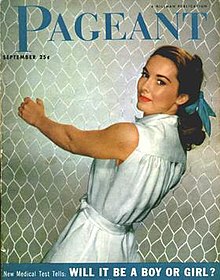|
Pageant (magazine)
Pageant was a 20th-century monthly magazine published in the United States from November 1944 until February 1977. Printed in a digest size format, it became Coronet magazine's leading competition, although it aimed for comparison to Reader's Digest. HistoryPageant was founded and first published by Hillman Periodicals. The first issue appeared in November 1944.[1] Publisher Alex L. Hillman saw Pageant as a prestigious addition to his magazine line that included true confessions (Real Romances, Real Story, Real Confessions), crime titles (Crime Detective, Real Detective, Crime Confessions) and comic books, and he went to press for a 500,000 print run on his first issue.[2] With an emphasis on visuals, Pageant often mixed glamour photo features with informative text on a wide range of subjects. Pageant was purchased by Macfadden Publications in 1961 and published its last issue in February 1977. EditorsAfter six years editing The American Mercury, Eugene Lyons, the first U.S. correspondent to interview Joseph Stalin, signed on as Pageant's first editor, offering a solid line-up of articles. So did Vernon Pope who took over as editor in May 1945. Even so, with a circulation of 270,000, the adless Pageant lost $400,000 for its publisher in 1946-47, mainly due to rising printing and paper costs in the postwar era. Typical of that year's contents was the September 1947 issue with articles on "Babies Before Birth," Greece, New England, pianist Alec Templeton, the photography of Louise Dahl-Wolfe and an interview with Bernard Baruch. Vernon Pope departed in 1947 and was replaced by a former Coronet managing editor, 30-year-old Harris Shevelson, who soon had the magazine turning a profit, with circulation climbing to 350,000 by March 1949, followed by a 400,000 print run for a wacky April Fool issue (April 1949).[3] Link with MadPageant indirectly figures into the history of Harvey Kurtzman's Mad, triggering the switch of Mad from a comic book to a magazine. In the early 1950s, Pageant did an article about the comic book Mad, illustrating it with an original double-page cartoon showing a parade of Mad characters. The drawing was created especially for Pageant by Kurtzman and Will Elder. Not long after that, Kurtzman received an offer to edit Pageant. Mad publisher Bill Gaines, in an interview with Steve Ringgenberg, explained what happened next:
 Shirley Bonne, an actress who appeared in the CBS comedy series My Sister Eileen (1960–61), appeared twice on the Pageant cover in the mid-1950s. References
Read Pageant
External links |
||||||||
